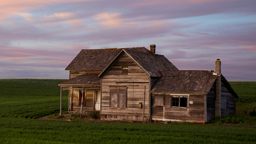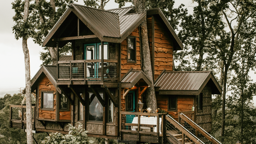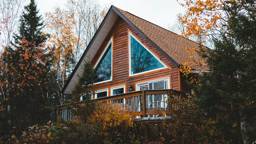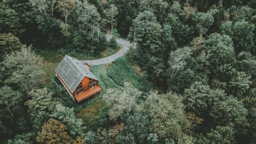
Photo by Jan Huber on Unsplash
By Wyatt Myers
When you imagine the perfect site for your dream cabin, there are probably at least a few trees in your vision. After all, there’s a reason many people choose a wooded lot for building their cabins, rather than a bare, tree-less site. Visualizing your beautiful cabin nestled in among the trees is easy: Actually building on a tree-covered lot can be tricky.
While trees are beautiful, they can also pose a number of challenges when it comes to actually building your home. Large root systems can present risks for driveways, foundations or septic systems. And the construction process can make some trees vulnerable and increase the risk of them falling in the years ahead.
For reasons of aesthetics and safety, give careful consideration to trees when planning to build your cabin. By making some important decisions upfront when it comes to which trees to keep, which trees to remove and which to plant, you can ensure that your cabin and trees can exist in perfect harmony for many years to come.
Surveying the Site
When you’re getting started on a new cabin, it’s easy to overlook the trees in favor of the home’s design. But Matthew Sullivan, a landscape architect with Sudbury Design Group in Massachusetts, says consideration of the trees should begin very early in the process. “Doing an initial site analysis of the lot and trees is the most important aspect of executing a successful design,” he says.
He suggests bringing a landscape architect to the site to examine the health and quality of the trees. The architect’s findings may shape the overall decision on house siting and landscape design. If the lot is heavily wooded, for example, it’s not as easy as simply clearing a wide swath of land to make room for the cabin.
“Trees in a forest setting work together,” says Wesley Kocher, a certified arborist and educational development manager of the International Society of Arboriculture. “The trees are typically tall, slender and have no lower branches. So if you clear for a home site, you create a void in protection. It can make the trees on the perimeter of the clearing more likely to take damage or even fall on the house at some point in the future.”
If possible, Kocher says you can overcome this concern by looking for a natural clearing on the land as a possible home site. Also, look for larger trees with lower branches. These have likely grown in more open conditions and should remain sturdy in the years ahead.
The roots are another key consideration. “Trees aren’t like carrots,” Kocher says. “Their roots often extend well beyond the canopy of the trees.” So you’ll need to give trees a wide berth when it comes to building your home’s foundation, driveway and septic system. Building too close to the tree poses the risk of future damage to some of your home’s essential components. And if you have to remove or excavate too much of the root system, it could greatly compromise the health of the tree, as well.

Photo by Matt Artz on Unsplash
Construction Considerations
Fortunately, there are a number of ways that trees and your cabin can coexist. Proper planning upfront and taking appropriate precautions before you build will protect trees you want to keep. The trees that remain on your site will not just look good; they will work hard, too.
The U.S. Forest Service estimates that properly placed trees can reduce a home’s need for heating and air-conditioning. The U.S. Department of Energy says that "carefully positioned trees can save up to 25% of the energy a typical household uses."
Saving trees is worthwhile. “Preventing compaction on the root mass can be controlled by installing temporary fencing around the trees’ canopy line,” Sullivan notes. “It is very important to stay out of the critical root zone for the construction process. Also some trees can be put on a fertilization program if they are required to be stressed during the construction process.”
Kocher suggests talking with your contractors to make sure tree health is promoted as much as possible. Some of the steps that help are simple, such as having a designated parking zone for construction vehicles that won’t harm the trees, or not depositing dug-up soil on top of a tree’s root system. When digging, it’s also important for contractors to stick to the original footprint of the foundation or driveway as closely as possible. Keeping tabs on excavation will minimize the impact on the surrounding tree root structures.
Obviously, you want to avoid damaging trees you hope to keep. But if damage does occur during the construction process, it’s probably best to take care of it immediately. “If a piece of equipment damages the roots extensively (bulldozer rash), the tree will probably die or get diseased,” says John Ricketson, project manager for Hearthstone in Macon, Georgia. It is much less expensive (and far less dangerous to people and property) to remove a questionable tree before construction starts, Ricketson says.

Photo by Lukasz Szmigiel on Unsplash
Where to Plant New Trees
The decision to add new trees to your property will depend on your site and your own wants and needs. “The planting design is based off a client’s desires, as well as taking functional purposes into account,” Sullivan says. “Trees can be planted for shade as well as aesthetics around the foundation of a house or around the terrace or patio.”
In general, however, two rules for planting trees are fairly consistent: It’s a good idea to plant deciduous trees on the exposed south and west faces of the home. “These offer shade in the warmer months of summer,” Kocher says. “Then, in the winter the leaves fall off and let the sun in for warmth.”
Be sure you know how large the trees you’re planting tend to grow and allow for enough space between your cabin or outbuildings and the new tree. Cabins in areas prone to wildfire must take extra precaution when planting trees. Knowing the direction of prevailing winds on your property will guide you in planting a windbreak. Kocher says conifer trees, which do not lose their leaves, can help protect your cabin from wind all year long.
The Arbor Day Foundation offers guidelines for choosing the right tree for your climate and the space available on your site. Go to arborday.org for more information.










